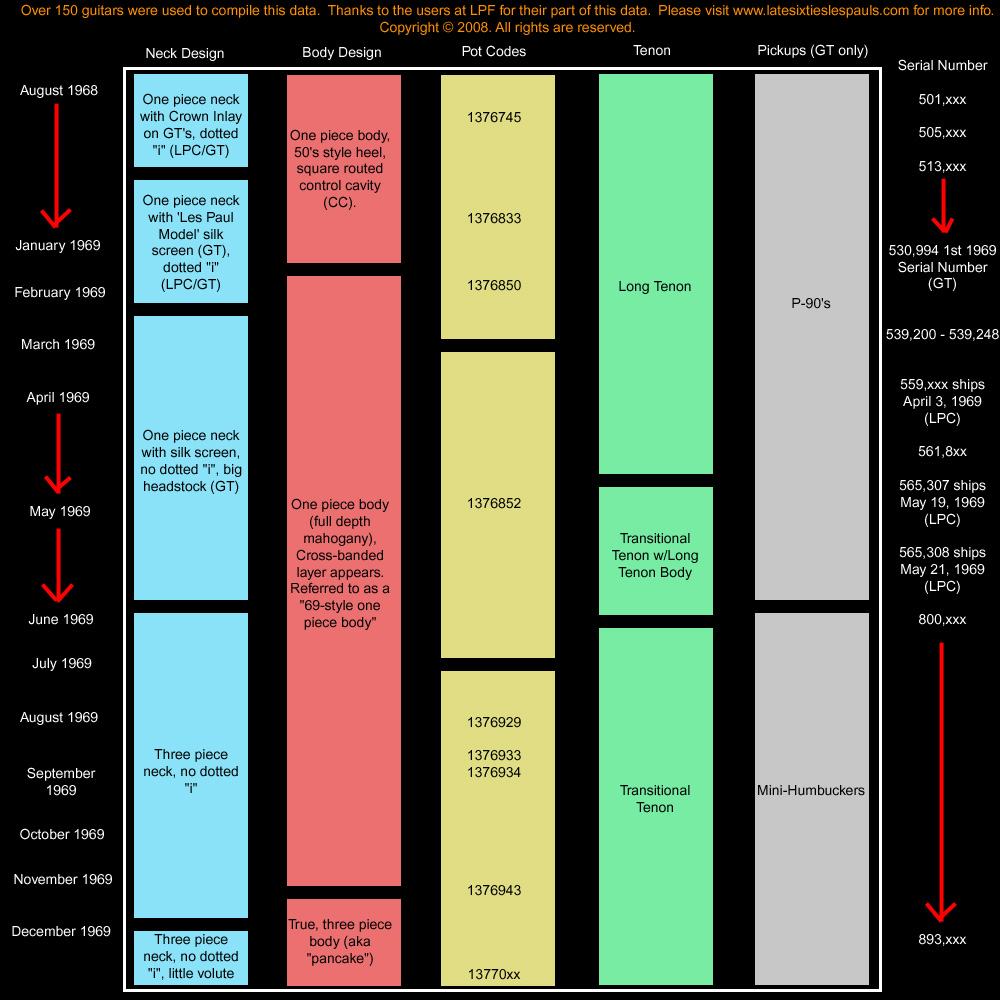Serial Number Info:
The serial numbers of LSLPs have been a source for confusion and ire for decades. With some of the numbers being reused multiple times in other years of production, it is not a surprise that many have thrown their hands up in frustration and given up trying to make sense of them. There are two sections to this page: First, I have compiled information from hundreds of guitars to create a timeline/graph of 1968 and 1969. This should answer the vast majority of your questions regarding when your guitar was produced. This information is reliable as it is keyed to quite a few shipping dates confirmed by the actual shipping ledger. Secondly, primarily for first time users and those needing a "quick and dirty" answer to what there guitar's serial number represents, I have created a "30 Second Guide" to identifying your guitar. The guide will even link you to the specific portions of this site that relate to your guitar.
Please note: This is not a COMPREHENSIVE serial number guide as I have left out some of the obscure variations of LSLP's for clarity's sake. 99% of LSLP's are covered here though. Shown in the navigation of this page, the sections of this site that are specific to each period of LSLP will cover the obscure examples excluded from this guide in detail.

Identify Your Guitar In 30 Seconds or Less.... Probably:
This section is intended to be a quick and dirty guide to ID'ing whether a guitar is a Late Sixties Les Paul (LSLP) using its serial number. If it is an LSLP, within thirty seconds you will know what era it came from and a general shipping date. You will also be linked directly to the dedicated section of this site that corresponds to your guitar.
IMPORTANT: This section is not intended to be a definitive guide for identifying your guitar. For speed's sake, I have ignored a few variations of serial numbers for this guide only. These variations comprise about 2% or less of all LSLP's produced and are documented on this site. In other words, for 98% of you, this "30 Second Guide" will get you where you need to go.
INSTRUCTIONS: Simply start at the top and follow the arrows down unitl you find a match. As Gibson repeated LSLP serial numbers in the 1970's, it is important to pay attention to the first box.

Is your guitar from the 1960's or the 1970's?
Gibson reused serial numbers from the LSLP period in about 1975 or so. Look at your headstock logo. Note the "b" and "o" in 'Gibson'. Now, look at the images below. Are they open like the left image? If so, you may have an LSLP, continue to the next boxes. Are they closed like the image on the right? Sorry, unless your guitar is a heavily modified or repaired LSLP, it is not from the sixties. Thanks for visiting the site anyway!
NO LSLP SHIPPED WITH "MADE IN THE USA" STAMPED BELOW THE SERIAL NUMBER.


Which serial number range does your guitar fall into?
501xxx - 505xxx?

You may have what I call a "First Series". These are the earliest and, by far, the most rare LSLP guitars. They were the first ones off the line since production of Les Pauls stopped in early 1961. They have lots of 1950's features as does the succeeding "Early Reissue" category. Your guitar may have shipped during the 3Q of 1968, and I wish you would sell to me for $5. :)
Want to learn more?
Want to be sure that your guitar fits in this category?
Click the jack plate below to plug into the part of my site that is about your type of LSLP.
Don't forget to visit "Common Features" for general information on LSLP guitars.


506xxx - 561xxx?

You may have what I call an "Early Series". These guitars have many 50's features including 1pc construction, P-90's, and long tenon neck joints. Since "First Reissues" are so rare, these "Early Reissues" are what people most commonly think of when they refer to "1968" Les Pauls. In truth, this era spans from the 4th quarter of 1968 through to the end of the 2nd quarter of 1969!
Want to learn more?
Want to be sure that your guitar fits in this category?
Click the jack plate below to plug into the part of my site that is about your type of LSLP.
Don't forget to visit "Common Features" for general information on LSLP guitars.


565xxx - 566xxx, 800xxx-891xxx?

You may have what I call a "Middle Series". The 'Les Paul Standard' with P-90s gave way to the 'Les Paul Deluxe' with Mini-humbuckers in this era. Necks became three piece laminates with a transitional tenon. These are GREAT guitars and are more reasonably priced in the vintage market than the earlier two variants. Your guitar may have shipped during the 3Q of 1969.
Want to learn more?
Want to be sure that your guitar fits in this category?
Click the jack plate below to plug into the part of my site that is about your type of LSLP.
Don't forget to visit "Common Features" for general information on LSLP guitars.


891xxx - 897xxx?

You may have what I call a "Later Series". These are the last of the LSLP guitars and are the least like their 50's counterparts. 3pc necks were joined with "pancake, 3pc" bodies. Left-handed production began as did the first neck volutes. These guitars are EXTREMELY late in 1969 and can possibly blend into 1970 as the serials transition into the 9xxxxx prefix.
Want to learn more?
Want to be sure that your guitar fits in this category?
Click the jack plate below to plug into the part of my site that is about your type of LSLP.
Don't forget to visit "Common Features" for general information on LSLP guitars.



